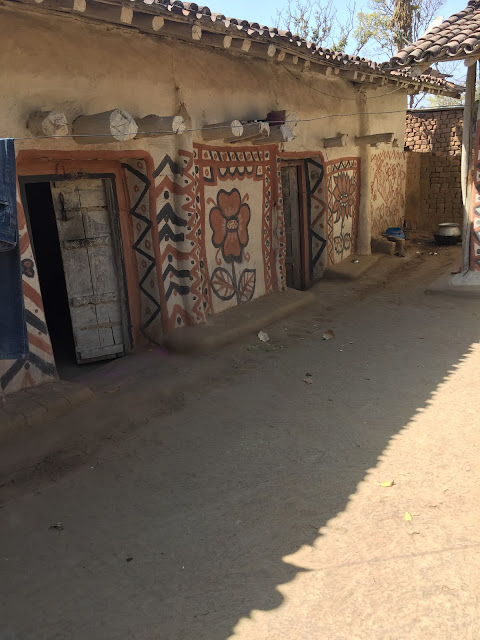The Hindu priest is telling visitors that this is an ancient lingam, but clearly it is Buddhist
According to Sir Edwin Arnold, in 'The Light of Asia,' Buddha came to Itkhori before his long walk to Bodhgaya where he was enlightened, and according to local legend, it was here at Itkhori that his aunt Prajapati Gautami lost him and screamed "iti koi" (iti = here koi = lost). Hence the derivation of the name Itkhori.
During the Gupta Period a ruler built a large Buddhist temple here. Later the temple became a Hindu temple and at some point it may even have become a Jain temple. But unlike many such temples in Cambodia, Laos and Thailand, which have remained as testimony to their changing religious affiliations, with a mixture of Buddhist and Hindu iconography, this temple was destroyed. Few people knew about it until sometime in the twentieth century, when farmers began to unearth stone sculptures with their ploughs and this came to the attention of Bulu Imam and his sons, who persuaded the villagers to keep the sculptures in a safe place.
Gradually over time a large quantity of stone sculptures and pieces of the architecture of the temple came to light and were stored in an old school. Eventually money was found for a makeshift 'museum' for them. The museum is kept locked but we were taken there by a caretaker who unlocked the doors, switched on the lights and ushered us in to a dusty room where Hindu, Jain and Buddhist sculptures and pieces of the old temple were stacked on top of each other in untidy rows with an occasional label in Hindi.
An application was made for Unesco status and funding was allocated, then suddenly the whole site was covered with concrete, obliterating the rest of the remnants of the ancient temple and a huge Hindu temple was built on the site. Had the site been carefully preserved it is possible that sufficient pieces of the old temple could have been unearthed to re-construct it, more or less as it originally was, as they did in Bodhgaya. But now it is too late. Sad remnants of the ancient temple still line the outer perimeters of the new temples. And Hindu worshippers worship a Buddhist Tara statue, mistaking her for Kali, in one of the Hindu temples.
The chief Minister has announced that he will build an enormous new Buddhist temple at Itkhori, which will go some way towards recognising it as a Buddhist site, but the temple will not include any of the old stone architecture. Large colour pictures of the projected Buddhist temple are displayed high up on the walls of the 'museum' at Itkhori. The Unesco application still awaits.
There are several villages around Itkhori where Buddhist sculptures have come to light. We visited Daihar village, a village of fifty two lanes and fifty two wells. Old Buddhist, Jain and Hindu statues have been pulled out of some of the wells, the better preserved pieces taken to Ranchi, the broken pieces piled in heaps in the lanes, where the villagers revere them with marks of vermillion, wrapping the odd piece in red cloth, as a mark of respect. As I stared down into the depths of one of the wells, too deep to see the water at the bottom, I marvelled at how, hundreds of years ago, these villagers could have dug and built the walls of such deep wells.
Over the years many ruins of the Buddhist monuments and statues have come to light in different parts of the state of Jharkhand. According to T. Bloch, several Buddhist remains were found five and seven kilometres from Dalmi and Budhpur in Dhanbad district, dating to the tenth century AD, according to Beglar. In 1918 FM Holo found Buddhist sculptures at Suraj Kund village in the Hazaribagh district near some hot springs. At Belwadag village, three km east of Khunti in Ranchi, an excavation has revealed a Buddhist Vihar, constructed of bricks similar to those used to build the Buddhist stupa at Sanchi. Buddhist statues have been discovered in places like Jonha of Ranchi district, Katunga village of Gumla district, Bhula village of Jamshedpur (East Singhbhum) and Ichagarh in Dhanbad district.
At Mangarh a brick work Buddhist Stupa, twenty feet by twenty feet has recently come to light. At Tultul, near a waterfall, Koleshwari temple is Buddhist, Jain and Hindu. Some of these statues and parts of monuments have been taken to the post-graduate department of history of Ranchi University, but they are not well cared for. In the current climate of Hindutva, little importance is given to Buddhist archeological remains in India.
The UNESCO application for recognition of Itkhori as an important Buddhist site still awaits a response. Hopefully if it is recognised, attention can be drawn to the importance of Jharkhand as a major Buddhist destination. If money is provided for excavation and a proper museum, many more Buddhist sites will probably come to light.















